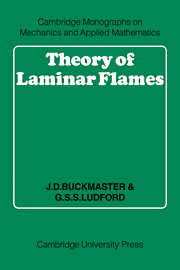Book contents
- Frontmatter
- Contents
- Preface
- 1 Governing equations of combustion
- 2 The premixed plane flame
- 3 Perturbations: SVFs and NEFs
- 4 Steady burning of a linear condensate
- 5 Unsteady burning of a linear condensate
- 6 Spherical diffusion flames
- 7 Cylindrical and spherical premixed flames
- 8 Multidimensional theory of premixed flames
- 9 Burners
- 10 Effects of shear and strain
- 11 Stability
- 12 Ignition and explosion
- Text references
- Further references
- Citation Index
- Subject Index
11 - Stability
Published online by Cambridge University Press: 05 May 2010
- Frontmatter
- Contents
- Preface
- 1 Governing equations of combustion
- 2 The premixed plane flame
- 3 Perturbations: SVFs and NEFs
- 4 Steady burning of a linear condensate
- 5 Unsteady burning of a linear condensate
- 6 Spherical diffusion flames
- 7 Cylindrical and spherical premixed flames
- 8 Multidimensional theory of premixed flames
- 9 Burners
- 10 Effects of shear and strain
- 11 Stability
- 12 Ignition and explosion
- Text references
- Further references
- Citation Index
- Subject Index
Summary
Scope
Flame stability is a very broad subject; both the mechanisms and manifestations of instability assume many forms. A whole monograph could be devoted to it if a less analytical approach than ours were adopted. It has been studied since the 1777 observations of Higgins (1802) on singing flames, a phenomenon involving interaction between an acoustic field and an oscillating flame of the kind described in Chapter 5. Such interactions were considered to be merely laboratory curiosities for many years, but lately they have assumed technological importance in the development of rocket motors and large furnaces. This type of instability is well understood qualitatively (Chu 1956). Other combustion phenomena thought to be due to instability are, in general, poorly understood; in some cases instability is merely suspected of playing a role but no certain evidence is yet available. The following examples are representative of the abundance of instability phenomena in combustion.
The stability of burner flames depends on an appropriate interaction between the flame and its surroundings, in particular, a flux of heat from the flame to the burner rim. The role of this flux in anchoring the flame and preventing blow-off has already been mentioned in Chapter 9.
Propagation limits are important questions in the study of premixed flames, with steady, sustained combustion being possible only for a certain range of the fuel to oxidant ratio. If a mixture is too rich or too lean it will not burn, and instability may well be involved.
- Type
- Chapter
- Information
- Theory of Laminar Flames , pp. 193 - 220Publisher: Cambridge University PressPrint publication year: 1982



